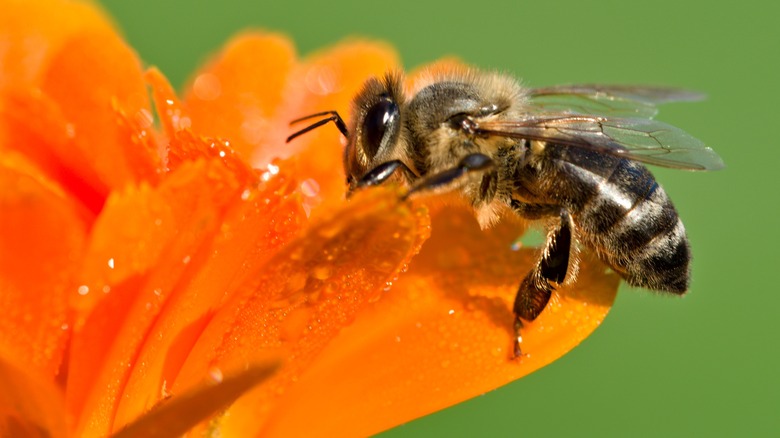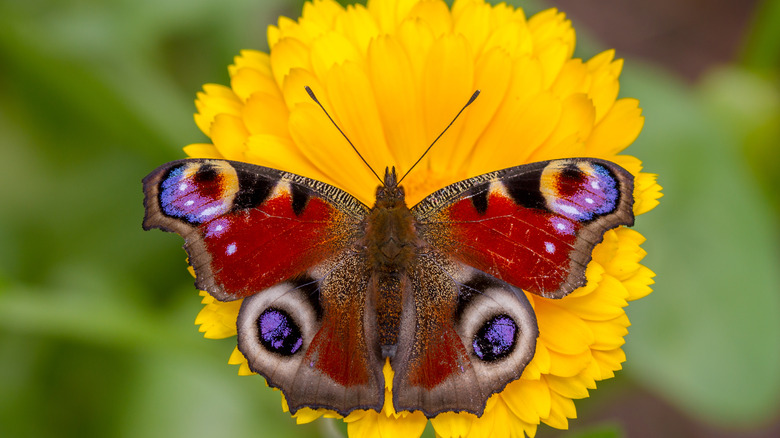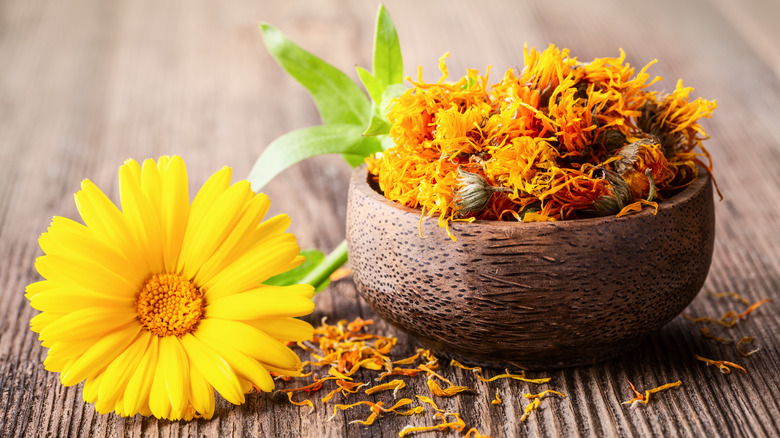The Edible Flower That'll Attract Bees And Pollinators To Your Garden
While every type of flower brings its beauty and value to the garden, there's something extra satisfying about nurturing a plant that serves multiple purposes. For a flower that can serve as food, dye, or medicine while adding a splash of color and attracting pollinators to your garden, grow calendula (Calendula officinalis). Also known as pot marigold, this brilliant orange flower attracts all the right insects to the garden and brightens up your favorite dishes! Calendula is relatively easy to grow. As an annual that prefers cooler temperatures, calendula thrives in early summer and late fall.
It's best to grow it by seed, sowing six to eight weeks before the last frost date in your area. If you live in a particularly warm climate, you can cut the plants back during the hottest summer months and allow them to revive when cooler autumn temperatures set in. Calendula needs well-drained soil and full or partial sun. Key threats are snails and slugs, so stay vigilant and monitor for them. Powdery mildew might affect your calendula plant. Luckily, you can get rid of powdery mildew in the garden with common kitchen staples. Enjoy the easy maintenance since all you need to do is pinch back dead flowers to keep the plant nice and bushy. If you let it, calendula will self-seed, repeatedly showing up in your garden.
Calendula and pollinators
Grow calendula as a companion plant to keep beneficial insects visiting your garden while repelling pests. Calendula is not overly picky about soil and will thrive as a border plant in pots or raised beds. The vibrant orange and yellow flowers attract butterflies, bees, and other essential pollinators. Calendula is rich in nectar and pollen, which are essential to the lifecycle of pollinators, making it one of the best plants for your pollinator garden. Its bright color, sweet scent, and nectar-rich flowers all help it attract beneficial pollinators and support thriving ecosystems in the process.
Whether you interplant calendula with vegetables in your garden beds or keep them in separate containers, positioning it near plants that need pollinators, like squash, cucumber, peppers, melon, and tomatoes, can help you achieve a thriving garden. Many gardeners plant calendula around the borders of their garden as a trap crop because of the resin that calendula produces. Aphids are more attracted to this resin than they are to most vegetables, so the calendula redirects these pests from your key crops. In the process, they also attract the beneficial insects that prey on aphids, such as ladybugs, hoverflies, and lacewings, which in turn contribute to pollination efforts!
Calendula in the home and kitchen
Many gardeners rely on calendula as a companion plant in the garden and for brilliant cut flowers, but the petals also have various uses in the home. Calendula is a traditional medicine for treating muscle spasms, stomach upset, cramps, and ulcers. Still, it's important to keep in mind that there is limited research supporting these uses. In some cases, calendula is applied topically to treat minor infections, prevent inflammation, and help wounds like small burns and cuts heal more quickly. Its high flavonoid content makes it a valuable medicinal plant.
In the kitchen, calendula petals can add vibrant flavor and color to dishes. It's a delicious edible flower that you can grow in your garden. Only the petals are edible, not the centers of the flowers. The petals add a tangy, spicy, peppery flavor with a bitter edge, perfect for adding another layer of color and spice to a dish. You can sprinkle them into soups or salads, mash them up to make a dye, or even try baking with them!


